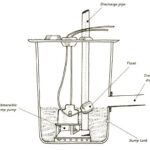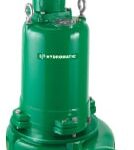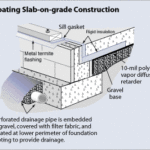A sump pump will help keep water out of your basement. This shows how a pedestal or submersible sump pump works, with a parts diagram.
A sump pump is a critical component in protecting your basement from flooding and water damage. Here’s a breakdown of the key parts and how they function together to keep your home dry.
Key Sump Pump Components
- Groundwater Collection System: Drain rock and drain tile are buried along the foundation (and sometimes under the floor) to capture groundwater. The drain tile channels this water into the sump tank.
- Sump Tank: Also called a “basin,” “crock,” or “sump pit,” the sump tank collects the incoming groundwater. Typically made of clay, tile, steel, concrete, fiberglass, or polyethylene, it’s usually around 18 inches in diameter and 2 to 3 feet deep. The sump tank is installed at the lowest point in the basement and has a cover to prevent debris from falling in.
- Pump: The pump is the heart of the system, responsible for removing the collected water. Most sump pumps are electric and come in two main types:
- Submersible: This type is completely submerged in the sump tank, making it quieter and more space-efficient.
- Pedestal: This type has a motor mounted on a column that extends above the sump tank, making it easier to access and service.
- Outlet Drain: The outlet drain carries the pumped water away from your home. Depending on local building codes, this may involve connecting to a sewer line or simply discharging the water through a hose to a safe distance from the foundation.
How Sump Pumps Work
- Groundwater Collection: Groundwater is collected by the drain tile and directed into the sump tank.
- Pump Activation: When the water level in the sump tank reaches a certain point, a float switch or other sensor activates the pump.
- Water Removal: The pump draws water from the tank through a filter trap (which should be cleaned regularly) and discharges it through the outlet drain.
- Pump Deactivation: Once the water level in the tank drops below a certain point, the pump automatically shuts off.
Additional Considerations
- Check Valve and Anti-Siphon Device: If connected to a sewer line, the discharge pipe should have a check valve to prevent backflow and an anti-siphon device to prevent contaminated water from being drawn back into the system.
- Discharge Location: Local building codes often dictate where the water can be discharged. It’s important to ensure the water is directed away from your foundation and neighboring properties.
- Maintenance: Regular maintenance is essential to keep your sump pump system functioning properly. This includes cleaning the filter trap (located at the intake point of the pump, where it draws water in from the tank), inspecting the pump for wear and tear, and testing the system periodically.
By understanding the basic components and operation of a sump pump, you can take proactive steps to protect your home from basement flooding and water damage.
Sump Pump FAQs
Q: What is a sump pump?
A: A sump pump is a device installed in the basement or crawlspace of a home to prevent flooding by removing accumulated groundwater.
Q: How does a sump pump work?
A: Groundwater is collected through a drainage system and channeled into a sump tank. When the water level in the tank rises, it triggers the pump to activate and discharge the water away from the house.
Q: What are the main parts of a sump pump system?
A: A sump pump system consists of a groundwater collection system (drain rock and drain tile), a sump tank, a pump, and an outlet drain.
Q: What types of sump pumps are there?
A: The two main types of sump pumps are submersible pumps (completely submerged in the tank) and pedestal pumps (motor mounted on a column above the tank).
Q: Where is the filter trap located?
A: The filter trap is located at the intake point of the sump pump, where it draws water in from the sump tank. In submersible pumps, it’s usually at the bottom or side of the pump housing; in pedestal pumps, it’s at the end of the intake pipe.
Q: Why is it important to clean the filter trap?
A: Cleaning the filter trap regularly prevents debris from clogging the pump and ensures proper function, preventing potential flooding.
Q: What is a check valve, and why is it important?
A: A check valve is installed in the discharge pipe to prevent backflow of water into the sump pump system, especially when connected to a sewer line.
Q: How often should I maintain my sump pump system?
A: Regular maintenance is crucial. This includes cleaning the filter trap, inspecting the pump for wear and tear, and testing the system periodically to ensure it’s working correctly.
Q: Where should the water from the sump pump be discharged?
A: The water should be discharged away from the foundation of your house and neighboring properties. Local building codes often dictate specific requirements for discharge location.
Q: What should I do if my sump pump fails?
A: If your sump pump fails, it’s crucial to address the issue promptly to prevent basement flooding. Contact a professional plumber for repairs or replacement.
Remember: A sump pump is a vital tool for protecting your home from water damage. Understanding its components and function, as well as performing regular maintenance, will help ensure its effectiveness in keeping your basement dry.



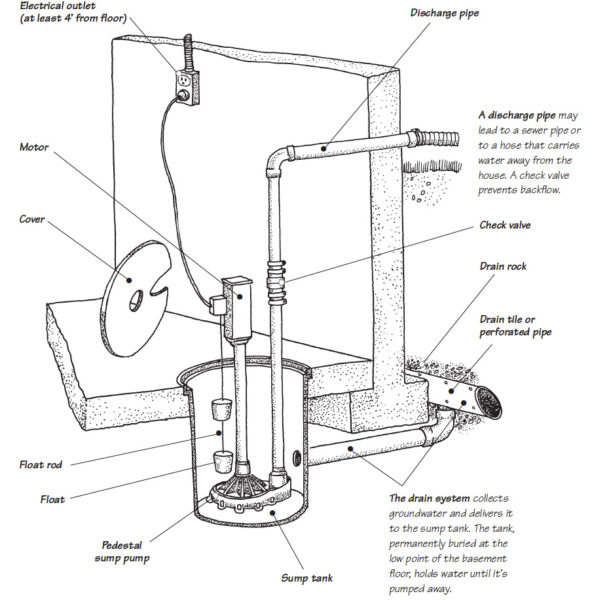
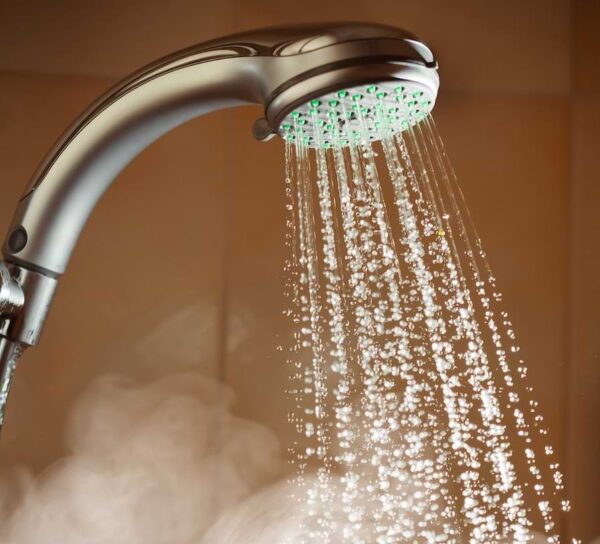

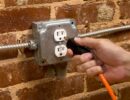

 Don Vandervort writes or edits every article at HomeTips. Don has:
Don Vandervort writes or edits every article at HomeTips. Don has:

